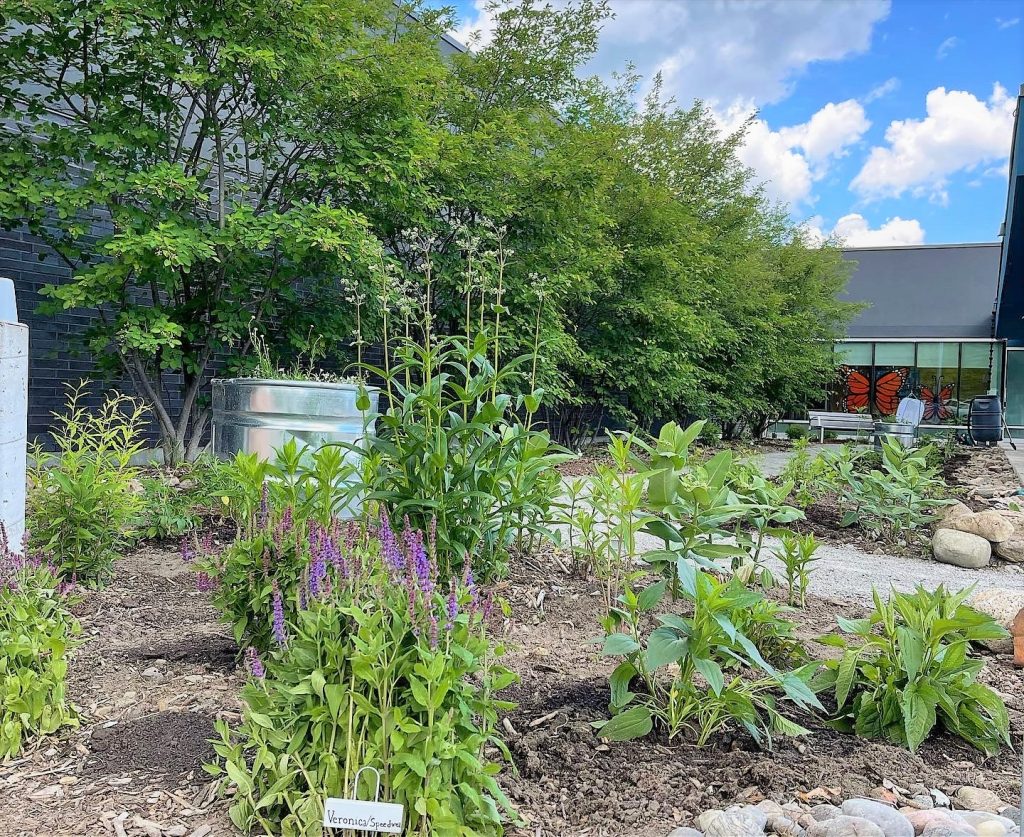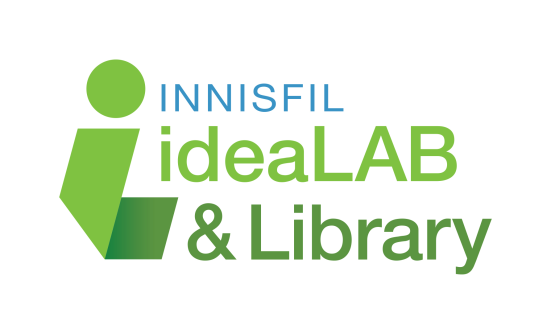
POLLINATOR GARDENS AT YOUR LIBRARY
The Innisfil ideaLAB & Library has pollinator gardens at the Lakeshore and Cookstown Branches. These gardens were planted to provide habitat for our pollinating insects and birds. They provide food from early spring to late fall, and include many host plants.
This year we were able to expand the pollinator garden at the Lakeshore Branch, thanks to a grant from the TD Friends of the Environment Foundation. The garden is now over 2700 square feet in size, and includes 39 species of native flowering plants! It features a wheelchair accessible path, accessible height planters, dry river beds, and rain barrels donated by InnServices. More features will be added this summer, including educational signage.
A special thanks to the more than 40 volunteers from the community who helped build the new garden.
Most of the plants in our pollinator gardens are native plants. Not only are some of them host plants, but they are often more attractive to pollinators which have evolved alongside the plants. The ways in which the plants are more suited to pollinators varies. Sometimes the flowers are the exact right size for a bee to fit into and transfer pollen, they may bloom at the same time an insect emerges after the winter and provide their only source of food, or they may have a fragrance that mimics the natural chemicals emitted by an insect species and therefore attract them to the plant for pollination.
WHAT’S A HOST PLANT?
A host plant is a plant that is necessary for an animal to complete its life cycle, in many cases, as a food source. One of the most widely known examples of a host plant is milkweed, which is the only food source for the caterpillar stage of the Monarch Butterfly. We have lots of milkweed in our gardens, and both gardens are registered Monarch Waystations.
GROWING MILKWEED
Help create more habitat for the Monarch Butterfly! Get free milkweed seeds from your library every fall and help support our Monarch Butterfly population. Milkweed seeds must go through a cold phase, called cold stratifying, in order to germinate.
Planting outdoors in the Fall (the easy way!)
- Sprinkle the seeds on top of the soil
- Cover with a thin layer of soil
- Put a marker where you planted them to remind you next spring
Growing indoors in the spring (start in March)
1. Soak seeds 1-2 hours
2. Drain & dry, then wrap in a damp paper towel
3. Put in a baggie and store in the fridge for30-60 days
4. Prepare small pots (2″) with soil
5. Place seeds on top of soil, and press gently (do not bury)
6. Use a spray bottle to moisten seeds and soil, keep moist
7. Keep all the soil moist by watering from the bottom – place pot in a tray of 1/2″ water for 10 minute
8. Keep the seeds in bright light
9. Plant outdoors in May, when seedlings are app. 2″ tall, after the last frost
MONARCH BUTTERFLY REARING PROGRAM
The Library started raising Monarch Butterflies from eggs and caterpillars in 2019. We collect the eggs and caterpillars directly from the milkweed in our pollinator gardens. Visit our Monarch Butterfly Rearing page for more information.
HOW CAN YOU HELP OUR POLLINATORS?
Plant native plants! If you have any outdoor space where you live, you can help pollinators by planting native plants. Whether you have acres of land or a small balcony, you can help. This is the single most important thing you can do.
What else can you do?
- Don’t use pesticides
- Delay spring clean-up of your yard so chrysalids and eggs overwintering in the dead leaves have time to emerge (wait until it’s consistently 10 degrees Celsius during the day)
- Become friendly with native insects – don’t assume all insects should be killed, learn who’s friendly and who’s invasive. Most insects are actually beneficial to our gardens.
- Participate in No Mow May – leave dandelions to flower, they are often the only food source for insects because most neighbourhoods lack native plants
- Don’t cut back or remove wild native plants, like milkweed
- Plant a diverse garden – this helps to prevent pests from getting out of control, and provides food for a longer period of time
LEARN MORE
Find books available to borrow from your Library on these topics:
EXPLORER BACKPACK KITS
Explorer Backpacks are kits designed to help get you outside. Each kit comes with 2 or more books on the topic, and equipment that enables you to delve into the wonders of nature. We’ve also put together a Resource Guide for each one so you can find apps, online resources, as well as more books to help with your learning journey. There are currently 6 kits for children and 2 for adults.
WEBSITES
iNaturalist: Look up plant and animal identifications and where to find themInstall the app on your phone to upload photos and get an i.d. Submit your own identifications for others to see.
Canadian Wildlife Federation Native Plant Encyclopedia: Information about native plants in Canada.
Pollinator Partnership: Eco-Regional Planting Guides: Find out what to plant in your garden to support pollinators.
Create a Pollinator Friendly Garden (David Suzuki Foundation): Ideas and tips on planting a pollinator garden.
PLANT LISTS: LAKESHORE BRANCH
NATIVE PLANTS
| PLANT | BENEFITS | |
| Zizia (Golden Alexander) | Attracts various pollinating insects. Host plant for: Eastern Tiger Swallowtail butterfly | |
| Milkweed – Ice Ballet | A varietal of Swamp Milkweed, with white flowers Attracts various pollinating insects. Host plant for Monarch butterfly, a species of special concern in Ontario. | |
| Milkweed – Swamp Grows wild in Innisfil. See our Milkweed Identification Guide.} | Attracts various pollinating insects. Host plant for Monarch butterfly, a species of special concern in Ontario. | |
| Milkweed – Common Grows wild throughout Innisfil. See our Milkweed Identification Guide. | Attracts various pollinators including hummingbirds. Host plant for Monarch butterfly, a species of special concern in Ontario. | |
| Milkweed – Butterfly Weed/Orange Milkweed | Attracts various pollinators including hummingbirds. Host plant for Monarch butterfly, a species of special concern in Ontario. | |
| Common Yarrow | Attracts various pollinators, many species of insects and birds. | |
| Wild Columbine | Attracts various pollinators including hummingbirds and butterflies. Host plant for: Columbine Duskywing butterfly. | |
| Nodding Onion | Attracts various pollinators. | |
| Pale Purple Coneflower | Attracts various pollinators and birds. Host plant for: Silvery Checkerspot Butterfly | |
| Green Headed Coneflower | Attracts various pollinators. Host plant for: Silvery Checkerspot Butterfly | |
| Obedient Plant/False Dragonhead | Attracts various pollinators, including hummingbirds. | |
| Flat Topped White Aster | Attracts various pollinators. Host plant for: Harris Checkerspot Butterfly and Pearl Crescent butterflies. | |
| Eastern Wild Columbine | Attracts various pollinators, including hummingbirds. Host plant for: Columbine Duskywing butterfly and Columbine Borer moth. | |
Sweet Joe Pye Weed | Attracts various pollinators. | |
| White Turtlehead | Attracts various pollinators. Host plant for: Red Admiral Butterfly, Eastern Comma Butterfly and Baltimore Checkerspot Butterfly. | |
| Blue Stemmed Goldenrod | Attracts pollinators and birds. | |
| Gray-headed Coneflower | Attracts pollinators and birds. | |
| Purple Coneflower | Attracts pollinators and birds. Host plant for: Silvery Checkerspot Butterfly and Wavy-lined Emerald Moth. | |
| Native Bee Balm | Attracts various pollinators, including hummingbirds. | |
| Narrowleaf Evening Primrose/Sundrops | Attracts pollinators. Genus of plant is the only food source for the Evening Primrose Sweat Bee, a native insect to Ontario with a conservation status of “Vulnerable” . Host plant for Primrose Moth. | |
| Blue False Indigo | Host plant for: Wild Indigo Duskywing Butterfly, Easter Tailed Blue Butterfly, Orange Sulphur Butterfly, Clouded Sulphur Butterfly, Frosted Elphin Butterfly and Hoary Edge Butterfly | |
| Canadian Serviceberry Tree | Attracts insects in spring, and birds and mammals with it’s fruit. | |
| Common Boneset | Attracts various pollinators, birds and butterflies. It provides nectar for butterflies in the adult life cycle stage. | |
| Large-leaved Aster | Attracts pollinators. Host plant for Pearl Crescent Butterfly | |
| Spotted Joe Pye Weed | Attracts butterflies and honeybees. Host plant for: Ruby Tiger Moth, and the Three-lined Flower Moth | |
| Dense Blazing Star | Attracts birds, butterflies, hummingbirds, and various pollinators. Host plant for Wavy-Lined Emerald Moth. | |
| Oswego Tea Beebalm | Attracts birds, hummingbirds, and various pollinators. | |
| Wild Bergamot Beebalm | Attracts birds, butterflies, hummingbirds, and various pollinators. | |
| Bloodroot | Attracts various pollinators. | |
| Cup Plant | Attracts birds, butterflies, hummingbirds, and other various pollinators. | |
| Veronica/Speedwell | Attracts various pollinators. | |
| Black-eyed Susan | Attracts various pollinators and birds. Host plant for: Silvery Checkerspot Butterfly. | |
| Pearly Everlasting | Attracts various pollinators, including butterflies. | |
| Heartleaf Foamflower | Attracts birds in the spring. | |
| Wintergreen | Attracts birds, mammals, and various pollinators. | |
| Field Pussytoes | Attracts butterflies, mammals, and other pollinators. Host plant for American Painted Lady Butterflies. | |
| Wild Strawberry | Attracts insects in spring, and birds and mammals with it’s fruit. | |
| Fragrant Sumac | Attracts birds, mammals, various pollinators, and is a winter food source. | |
| Purple Poppy Mallow | Attracts various pollinators. Host plant for Gray Hairstreak Butterfly. | |
| Blanketflower | Attracts various pollinators, including bees. |
PLANT LISTS: COOKSTOWN BRANCH
NATIVE PLANTS
| PLANT | BENEFITS | PHOTO |
| Black-eyed Susan | Attracts various pollinators and birds. Host plant for: Painted Lady Butterfly Gorgone Checkerspot Butterfly and Bordered Patch Butterfly. | |
| Blanket flower (yellow) | Attracts pollinators. Host plants for various moths of the schinia genua. | |
| Foxglove beardtongue | Attracts various pollinators, including hummingbirds. Host plant for: Chalcedony Midget Moth. | |
| Milkweed – Butterfly Weed/Orange Milkweed | Attracts various pollinators including hummingbirds. Host plant for Monarch butterfly, a species of special concern in Ontario. | |
| Milkweed – Common Grows wild throughout Innisfil. See our Milkweed Identification Guide. | Attracts various pollinators including hummingbirds. Host plant for Monarch butterfly, a species of special concern in Ontario. | |
| Milkweed – Ice Ballet | A varietal of Swamp Milkweed, with white flowers Attracts various pollinating insects. Host plant for Monarch butterfly, a species of special concern in Ontario. | |
| Milkweed – Swamp Grows wild in Innisfil. See our Milkweed Identification Guide.} | Attracts various pollinating insects. Host plant for Monarch butterfly, a species of special concern in Ontario. | |
| Milkweed – Whorled | Attracts various pollinating insects Host plant for Monarch butterfly, a species of special concern in Ontario. | |
| Native Bee Balm | Attracts various pollinators, including hummingbirds. | |
| Purple Coneflower | Attracts pollinators and birds. Host plant for: Silvery Checkerspot Butterfly and Wavy-lined Emerald Moth. | |
| Zizia (Golden Alexander) | Attracts various pollinating insects. Host plant for: Eastern Tiger Swallowtail butterfly |
NON-NATIVE PLANTS
- Butterfly Bush
- Lilac (Korean)
- Verbena (“Brandywine”)
- Hydrangea (“Limelight”)
- Deutzia (“Chardonnay Pearls”)
- Delphinium (white)
- Sedum (“Autumn Joy”)
- Speedwell (“Georgia Blue”)
This garden makeover is made possible by the TD Friends of the Environment Foundation.

